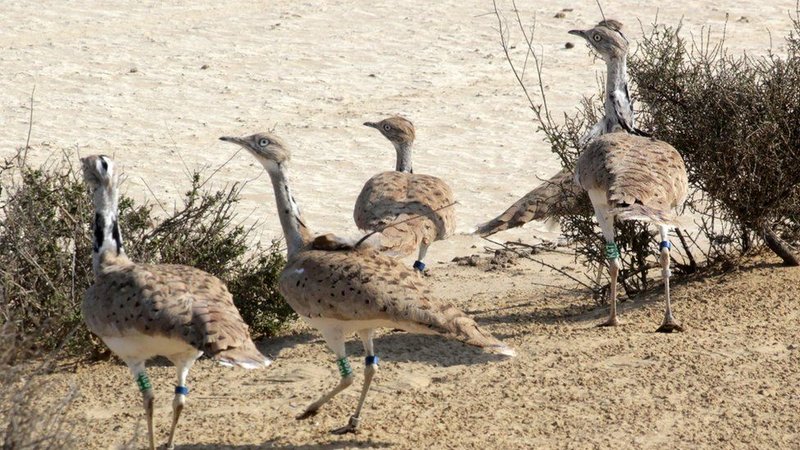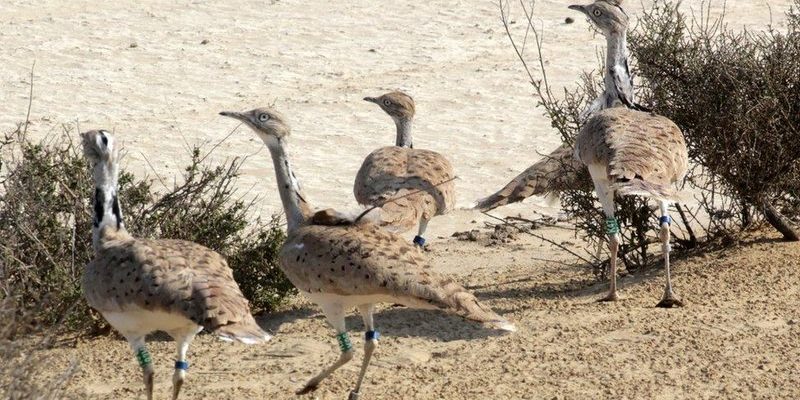
The Houbara Bustard is a magnificent bird that captures the imagination of many birdwatchers and nature enthusiasts. Picture a bird that stands tall, with long legs and a distinctive, elegant neck, strutting confidently in the arid landscapes of its habitat. When you see one in the wild, it’s like witnessing a piece of living art moving gracefully across the desert floor. These birds are not only fascinating for their looks but also for their unique behavior and adaptations that help them thrive in challenging environments.
You might be wondering where you can find the Houbara Bustard and what makes it so special. This bird inhabits a range of environments, primarily focusing on dry, open areas like grasslands, deserts, and semi-deserts. The Houbara Bustard has a rich cultural significance in many regions, particularly in the Middle East, where it’s highly regarded in falconry traditions. Let’s dive deeper into what makes this bird stand out in the vast avian world.
Physical Characteristics
The Houbara Bustard is a striking bird, known for its size and distinctive features. These birds can reach a height of about 60 to 75 centimeters (about 24 to 30 inches) and can weigh anywhere from 1.5 to 3.5 kilograms (3.3 to 7.7 pounds). One of its most notable features is its long neck and legs, which give it a regal appearance when it walks or runs. The feathers are typically light brown with dark streaks, providing excellent camouflage against the sandy and rocky terrains they inhabit.
During the breeding season, male Houbara Bustards display stunning courtship rituals, puffing up their chests and performing elaborate dances to attract females. Their plumage becomes even more vibrant during this time, making it easy to see why these birds are such a spectacle. Interestingly, the males have a prominent throat pouch that they inflate during displays, creating a unique sound that resonates across the land.
Habitat and Distribution
Houbara Bustards are predominantly found in North Africa and parts of Central Asia, with their presence recorded in countries such as Morocco, Egypt, and the United Arab Emirates. They prefer open landscapes where they can easily spot predators and forage for food. These birds are particularly comfortable in semi-arid regions, where low vegetation allows for easy movement and visibility.
These birds are migratory, with some populations moving south during the colder months in search of better foraging conditions. Understanding their migratory patterns can help conservationists protect their habitats and ensure that they have safe routes throughout the year. The challenges posed by habitat loss and climate changes have made it crucial to monitor their living conditions closely, allowing us to appreciate these birds even more.
Diet and Foraging Behavior
The diet of the Houbara Bustard is primarily herbivorous, consisting mainly of seeds, flowers, and leaves. However, they are opportunistic eaters and will also consume insects and small vertebrates when the chance arises. Their foraging behavior is quite interesting; they often feed alone or in small groups, using their keen eyesight to spot food from a distance.
During feeding, you’ll notice how methodically they search the ground. They pick up seeds and small plants with their long necks, showcasing their adaptability to the desert environment. This diet not only provides the necessary energy for their daily activities but also plays a vital role in seed dispersal, effectively supporting their ecosystem.
Reproduction and Nesting
The breeding season for Houbara Bustards typically begins in the spring. Males will engage in elaborate displays to attract females, showcasing their vibrant plumage and enchanting sounds. If a female is impressed, she will choose a mate, and together, they will create a nest on the ground, usually in a well-hidden location among grasses or shrubs.
The female usually lays around 1 to 3 eggs, which both parents help incubate. The incubation period lasts about 25 to 30 days, after which the chicks hatch, looking like miniature versions of their parents. They are precocial, meaning they can walk and feed themselves shortly after hatching. This early independence is crucial for survival in their challenging habitats.
Conservation Status
Unfortunately, the Houbara Bustard faces significant threats that have led to a decline in its population across many regions. Habitat loss due to agriculture and urbanization poses a severe challenge, while hunting and poaching have also contributed to their struggles. In some areas, these birds are legally protected, allowing conservationists to work toward their recovery.
Efforts to conserve the Houbara Bustard include habitat restoration, breeding programs, and educational campaigns focused on local communities. Initiatives such as the establishment of protected areas help safeguard their nesting sites, ensuring that future generations can witness the beauty of this remarkable bird. As we become more aware of their plight, we can help advocate for their protection.
Interesting Facts About the Houbara Bustard
| Common Name: | Houbara Bustard |
| Scientific Name: | Chlamydotis undulata |
| Habitat: | Deserts, grasslands, semi-arid regions |
| Length: | 60 to 75 cm |
| Weight: | 1.5 to 3.5 kg |
| Diet: | Herbivorous; seeds, insects, small vertebrates |
| Breeding Season: | Spring |
| Conservation Status: | Vulnerable |
FAQ
What is the primary habitat of the Houbara Bustard?
The Houbara Bustard primarily inhabits dry, open areas such as deserts and grasslands. They thrive in semi-arid regions where they can easily spot potential predators and forage for food. This habitat provides the necessary conditions for their survival, allowing them to adapt effectively to their environment.
How do Houbara Bustards attract mates?
During the breeding season, male Houbara Bustards perform elaborate courtship displays to attract females. This includes puffing up their chests, inflating their throat pouches, and engaging in intricate dances. These displays are not just visually impressive, but they also produce unique sounds that help capture the attention of potential mates.
Are Houbara Bustards migratory birds?
Yes, Houbara Bustards are migratory birds. Some populations move south during colder months to search for better foraging opportunities. Understanding their migratory patterns is essential for conservation efforts, as it ensures that they have safe routes and access to suitable habitats throughout the year.
What threats do Houbara Bustards face?
The Houbara Bustard faces several threats, including habitat loss due to agriculture and urban development, hunting, and poaching. These factors have led to a decline in their population, making conservation efforts crucial to their survival. Protecting their habitats and raising awareness about their plight are essential steps in safeguarding this remarkable bird.
How can we help conserve the Houbara Bustard?
There are various ways individuals can help conserve the Houbara Bustard. Supporting organizations focused on bird conservation, participating in local habitat restoration projects, and spreading awareness about their vulnerabilities are all effective actions. Additionally, advocating against illegal hunting and promoting sustainable practices in their habitats can greatly benefit their populations.
What is the diet of the Houbara Bustard?
The diet of the Houbara Bustard consists mainly of seeds, flowers, and leaves. However, they are known to be opportunistic feeders, consuming insects and small vertebrates when available. Their foraging behaviors and diet play a crucial role in ecosystem support, particularly in seed dispersal.
How long do Houbara Bustards live?
In the wild, Houbara Bustards typically have a lifespan of around 6 to 10 years, although some individuals may live longer under optimal conditions. Like many birds, their survival can be influenced by their environment, availability of food, and predation risks.

